Analysis of the Dihedral Corner Reflector’s RCS Features in Multi-Resource SAR
Abstract
:1. Introduction
2. The RCS Calculation Model for Dihedral CR
2.1. The Standard RCS Model of Dihedral CR
2.2. A Simplified RCS Model for a Dihedral CR Considering the Incident Angle Changes
2.3. The RCS Feature Comparison of Triangular and Dihedral CRs
3. The Novel Dihedral CR and SAR Data Set
3.1. The Novel Dihedral CR Design and Location
3.2. The Multi-Resource SAR Data
3.3. The Deviation Angles of the CR Array
4. The RCS Features of the CR Array in Multi-Resource SAR
4.1. The RCS Reduction Trend and Systematic Bias Analysis
4.2. The RCS Reduction Difference of CRs with Different Tilt Angles
4.3. The Theoretical Deformation Monitoring Accuracy in the Theory of the CR Array
5. Conclusions
Author Contributions
Funding
Data Availability Statement
Conflicts of Interest
References
- Zhang, G.; Jiang, Y.; Li, L.; Deng, M.; Zhao, R. Research progress of high-resolution optical/SAR satellite geometric radiometric calibration. Acta Geod. Cartogr. Sin. 2019, 48, 1604–1623. [Google Scholar]
- Li, T.; Tang, X.M.; Gao, X.M.; Chen, Q.F.; Zhang, X. Analysis and outlook of the operational topographic surveying and mapping capability of the SAR satellites. Acta Geod. Cartogr. Sin. 2021, 50, 891–904. [Google Scholar]
- Freeman, A. SAR calibration: An overview. IEEE Trans. Geosci. Remote Sens. 1992, 30, 1107–1121. [Google Scholar] [CrossRef]
- Xu, C.J.; He, P.; Wen, Y.M.; Yang, Y.L. Crustal Deformation Monitoring of Xianshuihe Fault by CR-InSAR. Geomat. Inf. Sci. Wuhan Univ. 2012, 37, 302–305. [Google Scholar]
- Huang, Q.; Zhang, F.; Li, L.; Liu, X.; Jiao, Y.; Yuan, X.; Li, H. Quick Quality Assessment and Radiometric Calibration of C-SAR/01 Satellite Using Flexible Automatic Corner Reflector. Remote Sens. 2023, 15, 104. [Google Scholar] [CrossRef]
- Shimada, M.; Isoguchi, O.; Tadono, T.; Isono, K. PALSAR Radiometric and Geometric Calibration. IEEE Trans. Geosci. Remote Sens. 2009, 47, 3915–3932. [Google Scholar] [CrossRef]
- Zhao, R.; Zhang, G.; Deng, M.; Yang, F.; Chen, Z.; Zheng, Y. Multimode Hybrid Geometric Calibration of Spaceborne SAR Considering Atmospheric Propagation Delay. Remote Sens. 2017, 9, 464. [Google Scholar] [CrossRef]
- Ferretti, A.; Savio, G.; Barzaghi, R.; Borghi, A.; Musazzi, S.; Novali, F.; Prati, C.; Rocca, F. Submillimeter Accuracy of InSAR Time Series: Experimental Validation. IEEE Trans. Geosci. Remote Sens. 2007, 45, 1142–1153. [Google Scholar] [CrossRef]
- Xing, X.M.; Zhu, J.J.; Wang, C.C.; Yi, H. A New Method for CR Point Identification and It’s Application to Highway Deformation Monitoring. Geomat. Inf. Sci. Wuhan Univ. 2011, 36, 699–703. [Google Scholar]
- Xia, Z.G.; Motagh, M.; Li, T. Performance Analysis of Dihedral Corner Reflectors for Slope Movements: A Case Study From Aniangzhai Landslide in China. IEEE Geosci. Remote Sens. Lett. 2022, 19, 1–5. [Google Scholar] [CrossRef]
- Liu, Z.; Bian, Z.; Liu, W. Monitoring of large and inconsistent deformation in coal mining area using point-like target offset tracking. Int. J. Remote Sens. 2022, 43, 1157–1177. [Google Scholar] [CrossRef]
- Jauvin, M.; Yan, Y.; Trouvé, E.; Fruneau, B.; Gay, M.; Girard, B. Integration of Corner Reflectors for the Monitoring of Mountain Glacier Areas with Sentinel-1 Time Series. Remote Sens. 2019, 11, 988. [Google Scholar] [CrossRef]
- Song, R.; Wu, J.; Ma, M.; Zhang, X.; Li, T. Absolute Geolocation of Corner Reflectors Using High-Resolution Synthetic Aperture Radar Images. J. Tongji Univ. (Nat. Sci.) 2021, 49, 1202–1210. [Google Scholar]
- Gisinger, C.; Balss, U.; Pail, R.; Zhu, X.X.; Montazeri, S.; Gernhardt, S.; Eineder, M. Precise Three-Dimensional Stereo Localization of Corner Reflectors and Persistent Scatterers With TerraSAR-X. IEEE Trans. Geosci. Remote Sens. 2014, 53, 1782–1802. [Google Scholar] [CrossRef]
- Yang, M.; López-Dekker, P.; Dheenathayalan, P.; Liao, M.; Hanssen, R.F. On the value of corner reflectors and surface models in InSAR precise point positioning. ISPRS J. Photogramm. Remote Sens. 2019, 158, 113–122. [Google Scholar] [CrossRef]
- Yang, M.; Dheenathayalan, P.; López-Dekker, P.; van Leijen, F.; Liao, M.; Hanssen, R.F. On the influence of sub-pixel position correction for PS localization accuracy and time series quality. ISPRS J. Photogramm. Remote Sens. 2020, 165, 98–107. [Google Scholar] [CrossRef]
- Weng, Y.K.; Li, S.; Yang, J.L.; Yi, H.; Wang, H.; Ma, Y. Fast Solution to the RCS of Corner Reflector for the SAR Radiometric Calibration. Geomat. Inf. Sci. Wuhan Univ. 2015, 40, 1551–1556. [Google Scholar] [CrossRef]
- Banyai, L.; Nagy, L.; Hooper, A.; Bozso, I.; Szucs, E.; Wesztergom, V. Investigation of Integrated Twin Corner Reflectors Designed for 3-D InSAR Applications. IEEE Geosci. Remote Sens. Lett. 2019, 99, 1–4. [Google Scholar] [CrossRef]
- Dheenathayalan, P.; Cuenca, M.C.; Hoogeboom, P.; Hanssen, R.F. Small Reflectors for Ground Motion Monitoring With InSAR. IEEE Trans. Geosci. Remote Sens. 2017, 99, 1–10. [Google Scholar] [CrossRef]
- Matthew, G. On the Design of Radar Corner Reflectors for Deformation Monitoring in Multi-Frequency InSAR. Remote Sens. 2017, 9, 648. [Google Scholar] [CrossRef]
- Czikhardt, R.; van der Marel, H.; van Leijen, F.J.; Hanssen, R.F. Estimating Signal-to-Clutter Ratio of InSAR Corner Reflectors From SAR Time Series. IEEE Geosci. Remote Sens. Lett. 2021, 99, 1–16. [Google Scholar] [CrossRef]
- Wang, S.Y.; Jeng, S.K. A compact RCS formula for a dihedral corner reflector at arbitrary aspect angles. IEEE Trans. Antennas Propag. 1998, 46, 1112–1113. [Google Scholar] [CrossRef]
- Griesser, T.; Balanis, C. Backscatter analysis of dihedral corner reflectors using physical optics and the physical theory of diffraction. IEEE Trans. Antennas Propag. 1987, 35, 1137–1147. [Google Scholar] [CrossRef]
- Anderson, W. Consequences of nonorthogonality on the scattering properties of dihedral reflectors. IEEE Trans. Antennas Propag. 1987, 35, 1154–1159. [Google Scholar] [CrossRef]
- Griesser, T.; Balanis, C.; Liu, K. RCS analysis and reduction for lossy dihedral corner reflectors. Proc. IEEE 1989, 77, 806–814. [Google Scholar] [CrossRef]
- Lu, T.; Wang, Y.; Yang, H.; Huang, X.; Zhou, Y.; Wu, J. Absorbing properties of metamaterial dihedral corner reflector. Mater. Res. Express 2020, 7, 025802. [Google Scholar] [CrossRef]
- Doerry, A.W. Reflectors for SAR Performance Testing. Reflection; Sandia National Lab.: Albuquerque, NM, USA, 2008; pp. 10–11. [CrossRef]
- Czikhardt, R.; Van Der Marel, H.; Papco, J. GECORIS: An Open-Source Toolbox for Analyzing Time Series of Corner Reflectors in InSAR Geodesy. Remote Sens. 2021, 13, 926. [Google Scholar] [CrossRef]

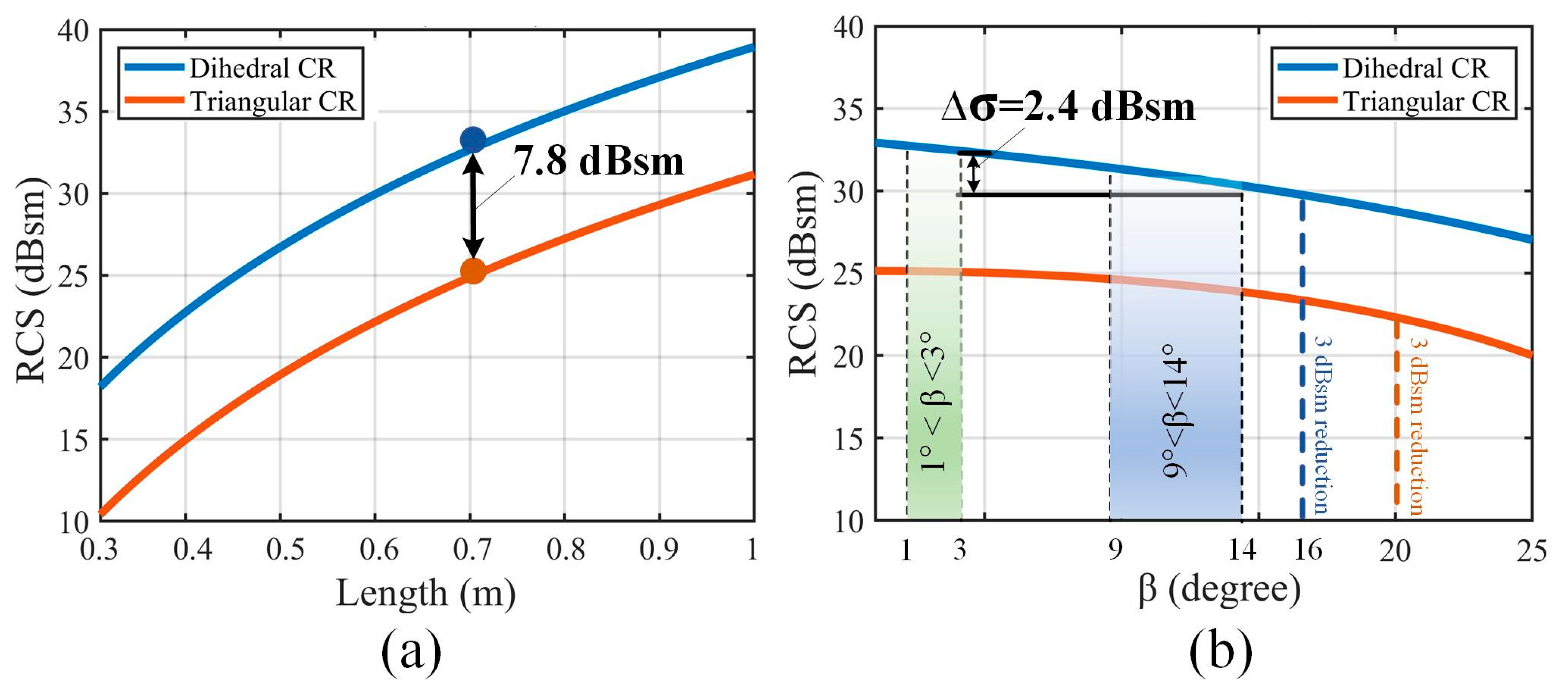
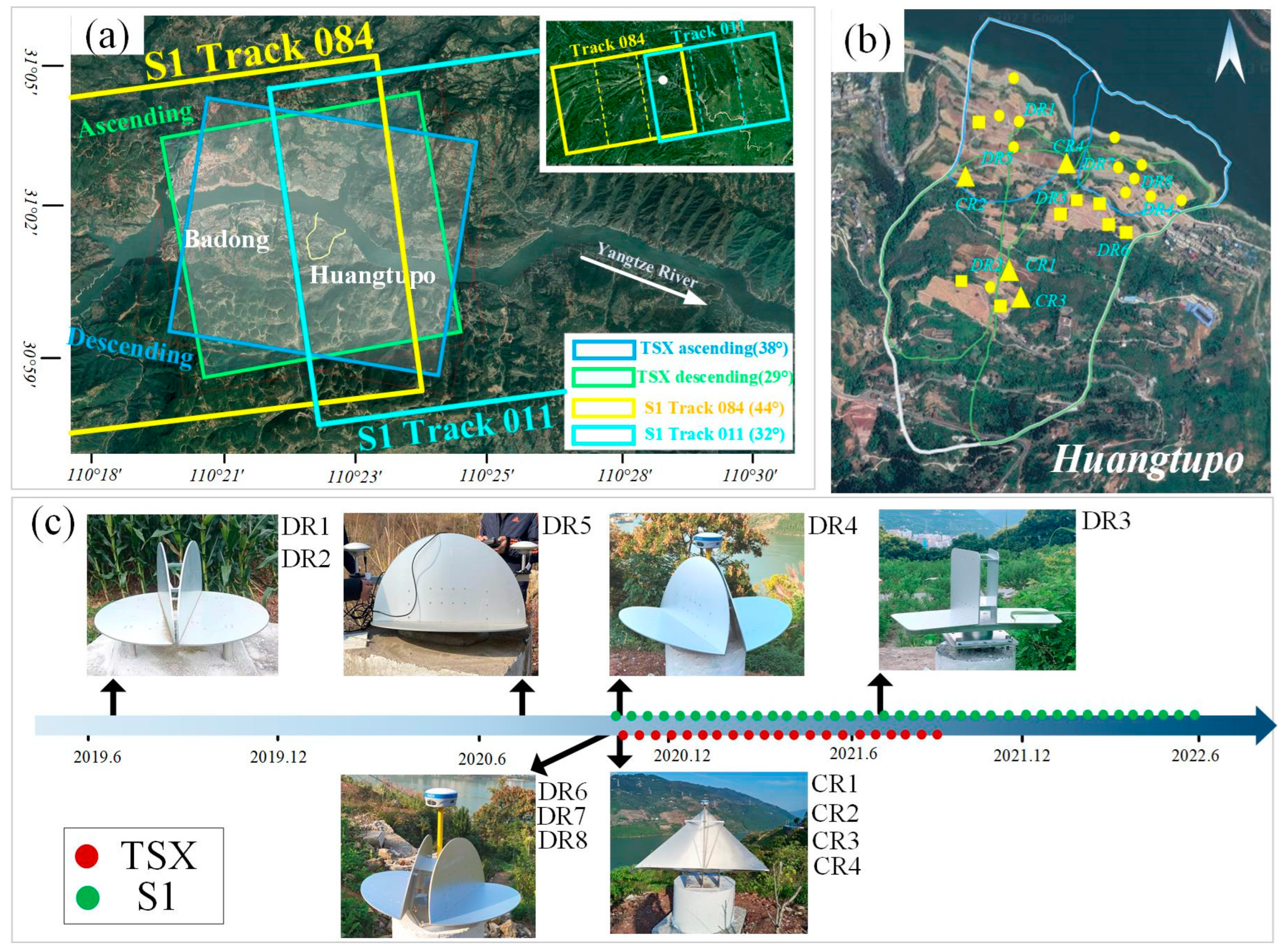

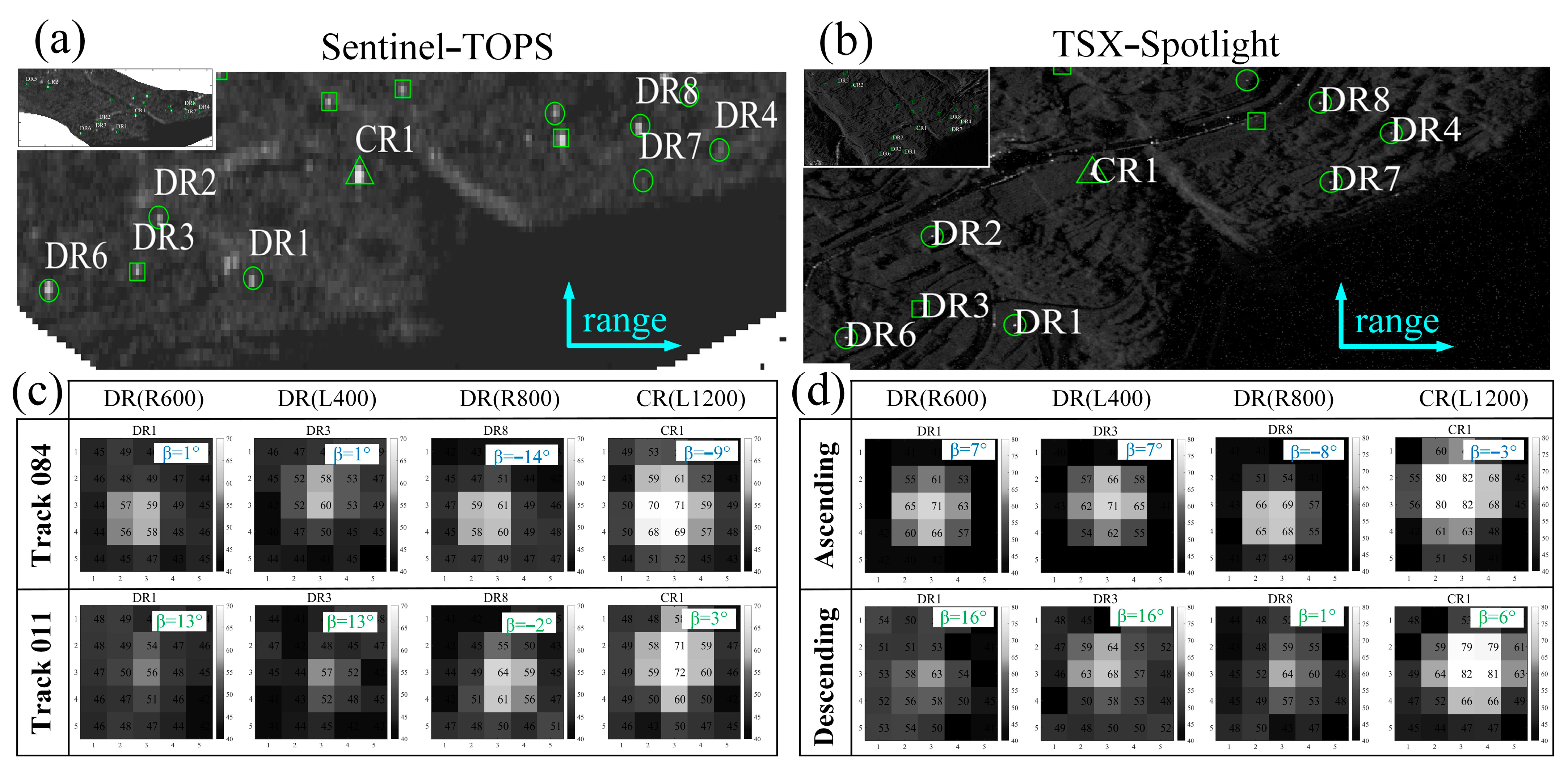
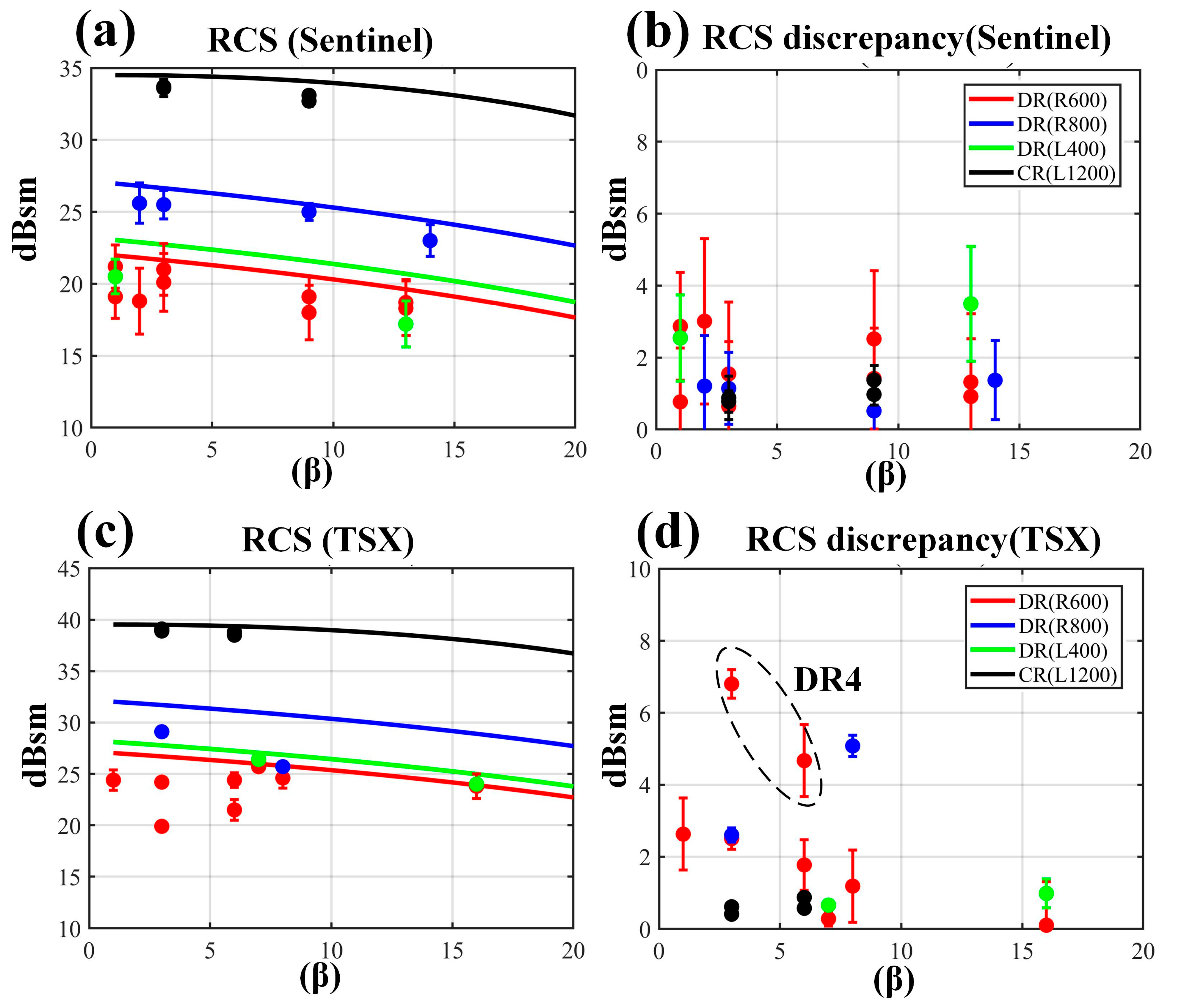



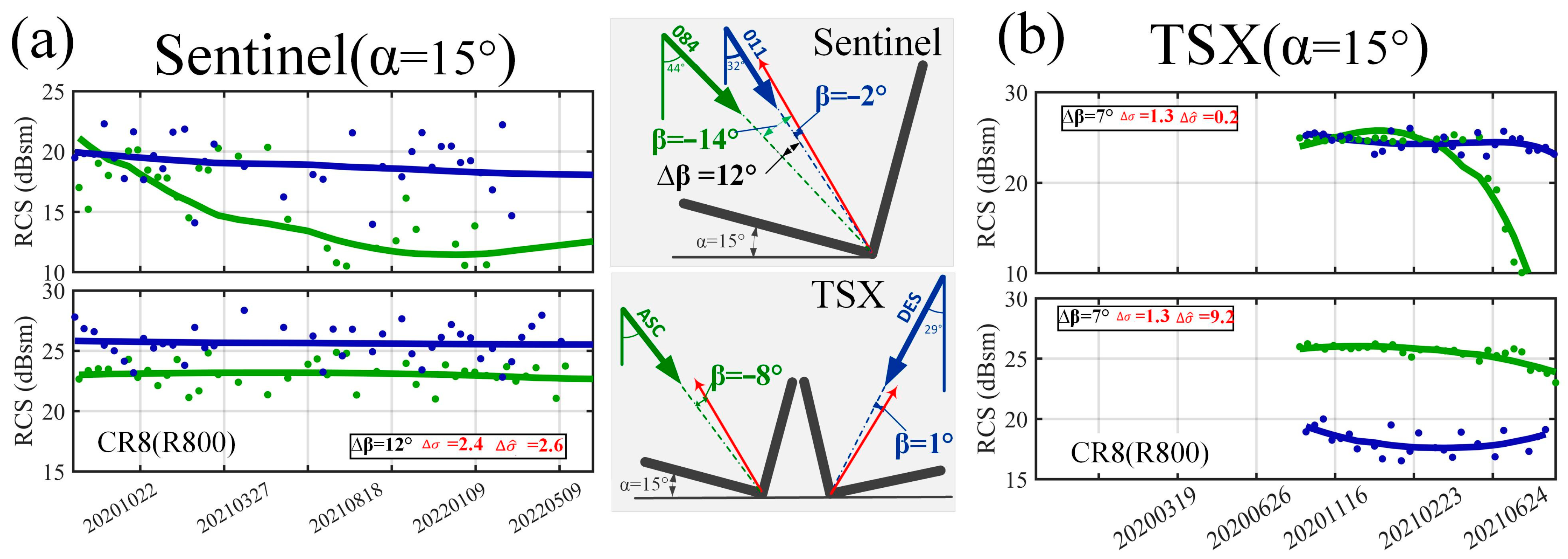
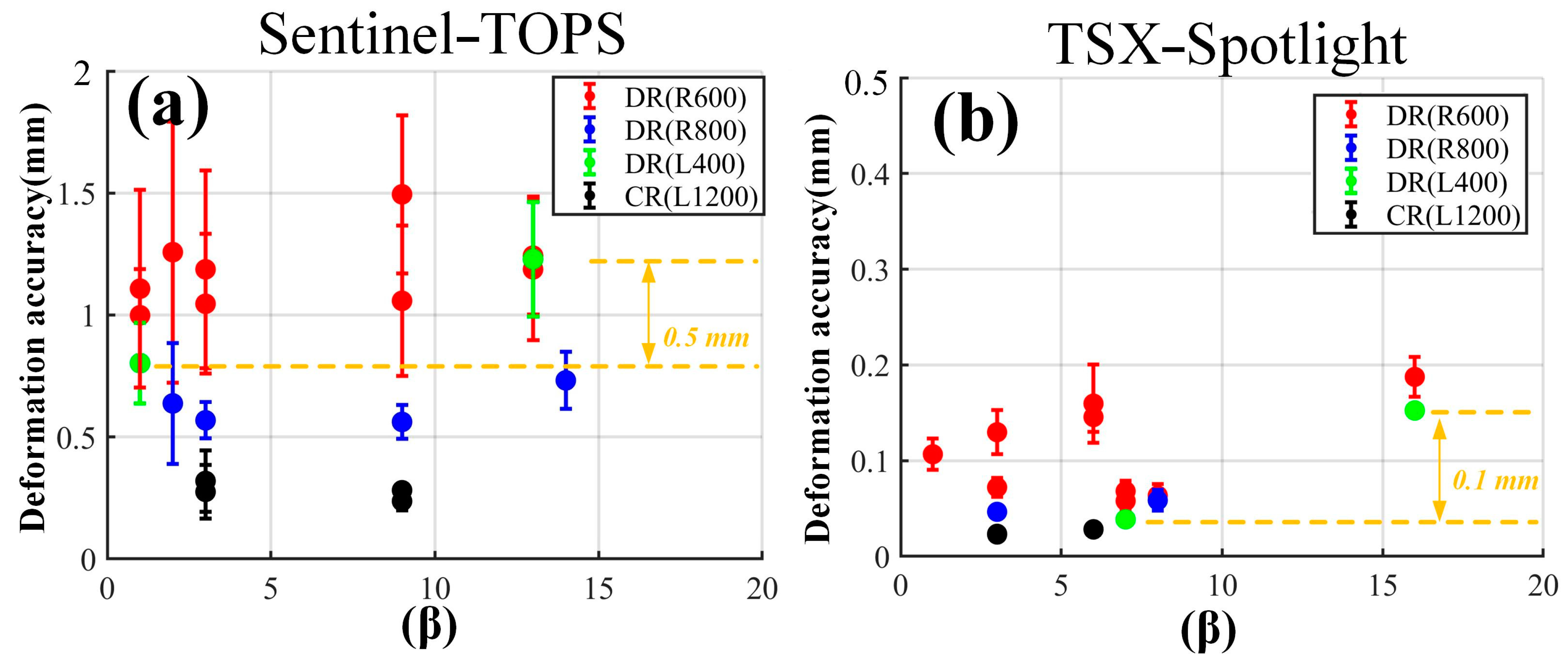
| SAR Sensor | TSX | Sentinel | ||
|---|---|---|---|---|
| band/wave length | X/3.1 cm | C/5.6 cm | ||
| orbit | Ascending | Descending | Ascending (084) | Ascending (011) |
| local incident angle | 38° | 29° | 44° | 32° |
| range resolution | 0.9 | 2.3 | ||
| azimuth resolution | 1.3 | 13.9 | ||
| Number | Type | Length /Diameter (m) | Tilt Angle (°) | Sentinel | TSX | |||||
|---|---|---|---|---|---|---|---|---|---|---|
(084 Track) | (011 Track) | (°) | (ASC) | (DES) | (°) | |||||
| First group | DR1~DR2 | semi-circular panel | ϕ = 0.6 | 0 | 1 | 13 | 12 | 7 | 16 | 9 |
| DR3 | square panel | a = 0.4 | 0 | 1 | 13 | 12 | 7 | 16 | 9 | |
| Second group | DR4~DR5 | semi-circular panel | ϕ = 0.6 | 10 | −9 | 3 | 6 | −3 | 6 | 3 |
| DR6 | semi-circular panel | ϕ = 0.8 | 10 | −9 | 3 | 6 | −3 | 6 | 3 | |
| Third group | DR7 | semi-circular panel | ϕ = 0.6 | 15 | −14 | −2 | 12 | −8 | 1 | 7 |
| DR8 | semi-circular panel | ϕ = 0.8 | 15 | −14 | −2 | 12 | −8 | 1 | 7 | |
| Fourth group | CR1~CR2 | Triangular CR (ascending) | l = 1.2 | 20 | −9 | 3 | 6 | |||
| CR3~CR4 | Triangular CR (descending) | l = 1.2 | 20 | −3 | 6 | 3 | ||||
Disclaimer/Publisher’s Note: The statements, opinions and data contained in all publications are solely those of the individual author(s) and contributor(s) and not of MDPI and/or the editor(s). MDPI and/or the editor(s) disclaim responsibility for any injury to people or property resulting from any ideas, methods, instructions or products referred to in the content. |
© 2024 by the authors. Licensee MDPI, Basel, Switzerland. This article is an open access article distributed under the terms and conditions of the Creative Commons Attribution (CC BY) license (https://creativecommons.org/licenses/by/4.0/).
Share and Cite
Liu, J.; Li, T.; Ma, S.; Wen, Y.; Xu, Y.; Nie, G. Analysis of the Dihedral Corner Reflector’s RCS Features in Multi-Resource SAR. Appl. Sci. 2024, 14, 5054. https://doi.org/10.3390/app14125054
Liu J, Li T, Ma S, Wen Y, Xu Y, Nie G. Analysis of the Dihedral Corner Reflector’s RCS Features in Multi-Resource SAR. Applied Sciences. 2024; 14(12):5054. https://doi.org/10.3390/app14125054
Chicago/Turabian StyleLiu, Jie, Tao Li, Sijie Ma, Yangmao Wen, Yanhao Xu, and Guigen Nie. 2024. "Analysis of the Dihedral Corner Reflector’s RCS Features in Multi-Resource SAR" Applied Sciences 14, no. 12: 5054. https://doi.org/10.3390/app14125054





